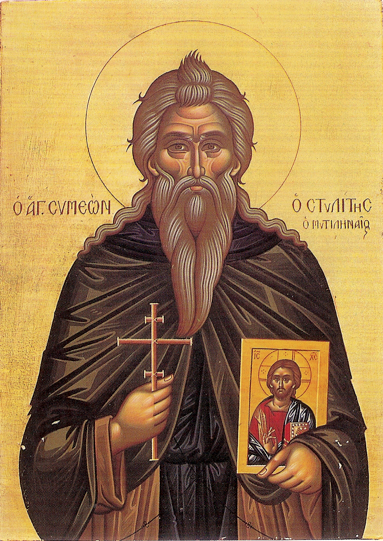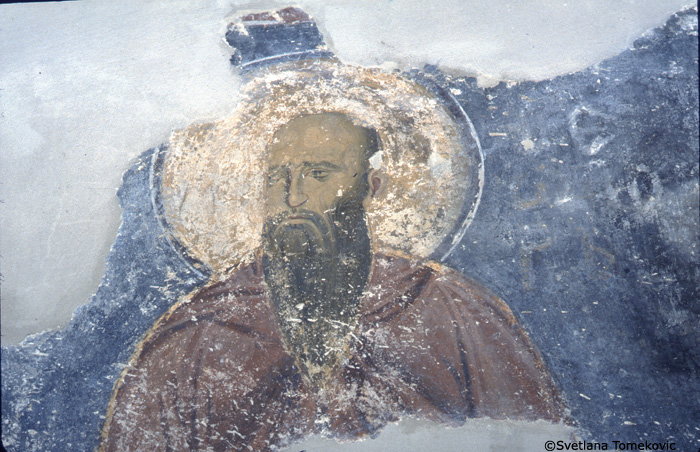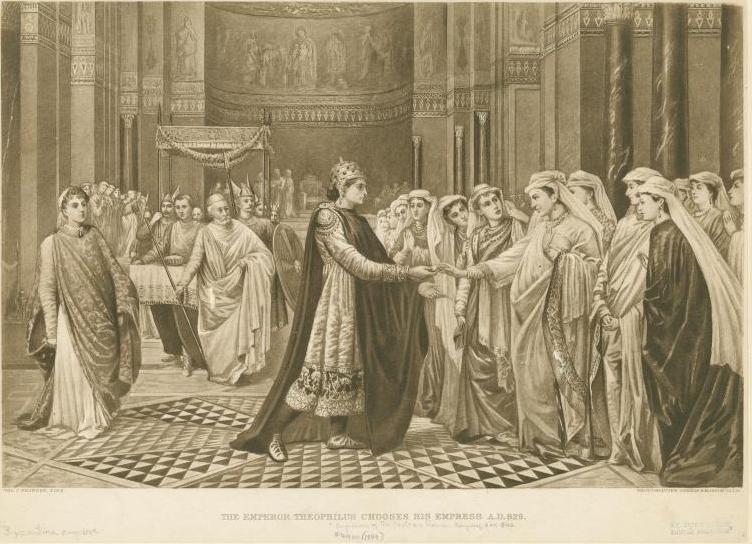|
Symeon Stylites Of Lesbos
Saint Symeon Stylites of Lesbos (765/66–844) was a monk who survived two attempts on his life during the second period of Byzantine Iconoclasm (814–842). He followed a similar model to Simeon Stylites, residing on a pillar-like structure similar to a tower. There he isolated himself from the world and fasted, prayed and studied. He is venerated with his two brothers, Saint George the Archbishop of Mytilene and Saint David the Monk. History In the beginning of the eighth century in Mytilene lived Adrianos and Konstanto. They had seven children, of which five became monks; three of the children were David, George and Symeon. David, the eldest, was born around 717 or 718 AD; he learned how to read and write by 16 and he was the shepherd of his father's sheep. During the time of a huge storm he saw a dream and Saint Anthony appeared to him and instructed him to travel to a monastery in Asia Minor, at Mount Ida. Exhibiting discipline at the mountain, he lived inside of a cave ... [...More Info...] [...Related Items...] OR: [Wikipedia] [Google] [Baidu] |
Agios Symeon Of Lesvos
''Agios'' ( el, Άγιος), plural ''Agioi'' (), transcribes masculine gender Greek words meaning 'sacred' or 'saint' (for example Agios Dimitrios, Agioi Anargyroi). It is frequently shortened in colloquial language to ''Ai'' (for example Ai Stratis). In polytonic script it is written ''Hagios'' () (for example Hagios Demetrios). It is also transliterated as, inter alia, ''Haghios'', ''Ayios'', ''Aghios'' (for example Ayios Dhometios, Aghios Andreas Beach, respectively) in the singular form, and ''Haghioi'', ''Ayioi'', ''Aghioi'', ''Ayii'' in the plural (for example Ayioi Omoloyites, Nicosia, Aghioi Theodoroi, Ayii Trimithias respectively). The feminine is ''agia'', ''ayia'', ''aghia'', ''hagia'' or ''haghia'' (Greek: or in polytonic form ), for example ''Agia Varvara'' (Saint Barbara). See also * * Agia (other), the feminine form of the word in Greek * Agis (other) * Agii (other) * Agius, a surname * ''Agos'', an Armenian newspaper * Agoi, a clan a ... [...More Info...] [...Related Items...] OR: [Wikipedia] [Google] [Baidu] |
Lesbos
Lesbos or Lesvos ( el, Λέσβος, Lésvos ) is a Greek island located in the northeastern Aegean Sea. It has an area of with approximately of coastline, making it the third largest island in Greece. It is separated from Anatolia, Asia Minor by the narrow Mytilini Strait. On the southeastern coast lies the island's capital and largest city, Mytilene, whose name is also used as a moniker for the island. The regional units of Greece, regional unit of Lesbos, with the seat in Mytilene, comprises the islands of Lesbos, Chios, Ikaria, Lemnos, and Samos. Mytilene is also the capital of the larger North Aegean region. The population of the island is 83,068, a third of whom live in the capital, while the remainder is distributed in small towns and villages. The largest are Plomari, Kalloni, the Gera Villages, Agiassos, Eresos, and Molyvos (the ancient Mythimna). According to later Greek writers, Mytilene was founded in the 11th century BC by the family Penthilidae, who arrived from T ... [...More Info...] [...Related Items...] OR: [Wikipedia] [Google] [Baidu] |
Little Hagia Sophia
Little Hagia Sophia Mosque (church) ( tr, Küçük Ayasofya Camii), formerly the Church of Saints Sergius and Bacchus ( el, , ''Ekklēsía tôn Hagíōn Sergíou kaì Bákchou en toîs Hormísdou''), is a former Greek Eastern Orthodox church dedicated to Saints Sergius and Bacchus in Constantinople, built between 532 and 536, and converted into a mosque during the Ottoman Empire. This Byzantine building with a central dome plan was erected in the sixth century by Justinian; despite its Turkish name, it likely was not a model for Hagia Sophia ("Holy Wisdom"), with which its construction was contemporary, but it is nonetheless one of the most important early Byzantine buildings in Istanbul. It was recognized at the time by Procopius as an adornment to the entire city, and a modern historian of the East Roman Empire has written that the church "by the originality of its architecture and the sumptuousness of its carved decoration, ranks in Constantinople second only to St Sophia i ... [...More Info...] [...Related Items...] OR: [Wikipedia] [Google] [Baidu] |
Methodios I Of Constantinople
St. Methodios I or Methodius I ( el, Μεθόδιος Α΄), (788/800 – June 14, 847) was Ecumenical Patriarch of Constantinople from March 4, 843 to June 14, 847. He was born in Syracuse and died in Constantinople. His feast day is celebrated on June 14 in both the East and the West. Life Born to wealthy parents, Methodios was sent as a young man to Constantinople to continue his education and hopefully attain an appointment at court. But instead he entered a monastery in Bithynia, eventually becoming abbot. Under Emperor Leo V the Armenian (813–820) the Iconoclast persecution broke out for the second time. In 815 Methodios went to Rome, perhaps as an envoy of the deposed Patriarch Nikephorοs. Upon his return in 821 he was arrested and exiled as an iconodule by the Iconoclast regime of Emperor Michael II. Methodios was released in 829 and assumed a position of importance at the court of the even more fervently iconoclast Emperor Theophilos. Soon after the death ... [...More Info...] [...Related Items...] OR: [Wikipedia] [Google] [Baidu] |
Theophanes The Branded
Theodorus (ca. 775–ca. 842) and Theophanes (ca. 778–845), called the ''Grapti'' (from the Greek graptoi, "written upon"), are remembered as proponents of the veneration of icons during the second Iconoclastic controversy. They were brothers and natives of Jerusalem. Joint history Theophanes '' Vita prima'' was recorded in the ''Life of Michael the Synkellos''. Theophanes and his brother Theodore were born in Palestine near the end of the eighth century, sons of the Venerable Jonah the Presbyter. Both grew up in Jerusalem, entered the Monastery of Mar Sabba near Bethlehem together, and became disciples of Michael the Synkellos (later ''syncellus'' of the Patriarch of Jerusalem). In 813 Michael and his two disciples left Jerusalem originally on a journey to Rome. They had been sent by the Patriarch of Jerusalem to support the Pope in his stand against the Franks over the question of the filioque, which some Benedictines from the West had recently introduced to Jerusal ... [...More Info...] [...Related Items...] OR: [Wikipedia] [Google] [Baidu] |
Sea Of Marmara
The Sea of Marmara,; grc, Προποντίς, Προποντίδα, Propontís, Propontída also known as the Marmara Sea, is an inland sea located entirely within the borders of Turkey. It connects the Black Sea to the Aegean Sea via the Bosporus and Dardanelles straits, separating the country's European and Asian sides. The Sea of Marmara is a small sea with an area of , and dimensions of . Its greatest depth is . Name The Sea of Marmara is named after the largest island to its south side which is called Marmara Island because it is rich in marble (Greek (''mármaron'') "marble)." In classical antiquity it was known as the Propontis, which is derived from the Greek words ''pro-'' (before) and ''pontos'' (sea) and reflects the fact that the Ancient Greeks used to sail through it to reach the Black Sea that they called Pontos. Mythology In Greek mythology, a storm on the Propontis brought the Argonauts back to an island they had left, precipitating a battle in which ... [...More Info...] [...Related Items...] OR: [Wikipedia] [Google] [Baidu] |
Avşa
Avşa Island ( tr, Avşa Adası) or Türkeli is a Turkish island in the southern Sea of Marmara with an area of about . It was the classical and Byzantine Aphousia ( el, Ἀφουσία or Ἀφησιά) and was a place of exile during the Byzantine period. The Greek inhabitants fled to Sarti Chalkidiki after the 1923 population exchange. The island belongs to the Marmara District of Balıkesir Province in northwestern Turkey. It is a popular domestic tourist destination, especially for tourists from Istanbul. The local population is around 2,000 according to the last census, but during the summer season the number of visitors increases as far as forty to fifty thousand. Transportation The island is within reach from Istanbul by ship and ferry. It is also accessible from Erdek and Tekirdağ by motorboat. Location The exact location of Avşa island is shown in the following map in red color. The larger island north of Avşa is the island of Marmara and the island to the east ... [...More Info...] [...Related Items...] OR: [Wikipedia] [Google] [Baidu] |
Theodora (wife Of Theophilos)
Theodora (Greek language, Greek: Θεοδώρα; 815 – c. 867), sometimes called Theodora the Armenian or Theodora the Blessed, was Byzantine empress as the wife of Byzantine emperor Theophilos (emperor), Theophilos from 830 to 842 and regent for the couple's young son Michael III, after the death of Theophilos, from 842 to 856. She is sometimes counted as an empress regnant, who actually ruled in her own right, rather than just a regent. Theodora is most famous for bringing an end to the second Byzantine Iconoclasm (814–843), an act for which she is recognized as a saint in the Eastern Orthodox Church. Though her reign saw the loss of most of Sicily and failure to retake Crete, Theodora's foreign policy was otherwise highly successful; by 856, the Byzantine Empire had gained the upper hand over both First Bulgarian Empire, Bulgaria and the Abbasid Caliphate, and the Slavs, Slavic tribes in the Peloponnese had been forced to pay tribute, all without decreasing the imperial g ... [...More Info...] [...Related Items...] OR: [Wikipedia] [Google] [Baidu] |
Theophilos (emperor)
Theophilos ( gr, Θεόφιλος; sometimes Latinized or Anglicized as Theophilus or Theophilo; c. 812 20 January 842) was the Byzantine Emperor from 829 until his death in 842. He was the second emperor of the Amorian dynasty and the last emperor to support iconoclasm.Timothy E. Gregory (2010). ''A History of Byzantium''. Blackwell Publishing Ltd. p. 227. Theophilos personally led the armies in his long war against the Arabs, beginning in 831. Life Early Theophilos was the son of the Byzantine Phrygian Greek Emperor Michael II and his wife Thekla, and the godson of Emperor Leo V the Armenian. Michael II crowned Theophilos co-emperor in 821. The date is almost universally given as 12 May 821 (Whitsunday), although this is not really corroborated by any source (another possible date is 24 March, Easter). Unlike his father, Theophilos received an extensive education from John Hylilas, the grammarian, and was a great admirer of music and art. On 2 October 829, Theophilos suc ... [...More Info...] [...Related Items...] OR: [Wikipedia] [Google] [Baidu] |
Black Sea
The Black Sea is a marginal mediterranean sea of the Atlantic Ocean lying between Europe and Asia, east of the Balkans, south of the East European Plain, west of the Caucasus, and north of Anatolia. It is bounded by Bulgaria, Georgia, Romania, Russia, Turkey, and Ukraine. The Black Sea is supplied by major rivers, principally the Danube, Dnieper, and Don. Consequently, while six countries have a coastline on the sea, its drainage basin includes parts of 24 countries in Europe. The Black Sea covers (not including the Sea of Azov), has a maximum depth of , and a volume of . Most of its coasts ascend rapidly. These rises are the Pontic Mountains to the south, bar the southwest-facing peninsulas, the Caucasus Mountains to the east, and the Crimean Mountains to the mid-north. In the west, the coast is generally small floodplains below foothills such as the Strandzha; Cape Emine, a dwindling of the east end of the Balkan Mountains; and the Dobruja Plateau considerably farth ... [...More Info...] [...Related Items...] OR: [Wikipedia] [Google] [Baidu] |
Dardanelles
The Dardanelles (; tr, Çanakkale Boğazı, lit=Strait of Çanakkale, el, Δαρδανέλλια, translit=Dardanéllia), also known as the Strait of Gallipoli from the Gallipoli peninsula or from Classical Antiquity as the Hellespont (; grc-x-classical, Ἑλλήσποντος, translit=Hellēspontos, lit=Sea of Helle), is a narrow, natural strait and internationally significant waterway in northwestern Turkey that forms part of the continental boundary between Asia and Europe and separates Asian Turkey from European Turkey. Together with the Bosporus, the Dardanelles forms the Turkish Straits. One of the world's narrowest straits used for international navigation, the Dardanelles connects the Sea of Marmara with the Aegean and Mediterranean seas while also allowing passage to the Black Sea by extension via the Bosporus. The Dardanelles is long and wide. It has an average depth of with a maximum depth of at its narrowest point abreast the city of Çanakkale. Th ... [...More Info...] [...Related Items...] OR: [Wikipedia] [Google] [Baidu] |
Tirilye
Tirilye (also known as Zeytinbağı, ''Olive yard'') is a town in Bursa Province, Turkey, situated west of Mudanya along the Marmara seashore. The area, which was inhabited since the eighth century BC, was formerly known as Τρίγλεια, ''Trigleia'' or Βρύλλειον, ''Brylleion'' in Greek. The most important historical structure in Trilye (Triglia) is that of the Byzantine Haghios Stefanos Church (Hinolakkos Monastery, 780 AC), known today as the Fatih Mosque. Mudanya, a residential and commercial development in this township is under state protection as a historical site. Trilye has been an important religious center for Greek Orthodox Christians during Byzantine Empire. Of most churches and monasteries only ruins remain. Trilye is a first level protected area since 1981 (decision of the High Council of Monuments 12588/13.3.1981) because of the Byzantine and Ottoman architectural monuments and is considered as an open-air museum thanks to the historical buildings a ... [...More Info...] [...Related Items...] OR: [Wikipedia] [Google] [Baidu] |







